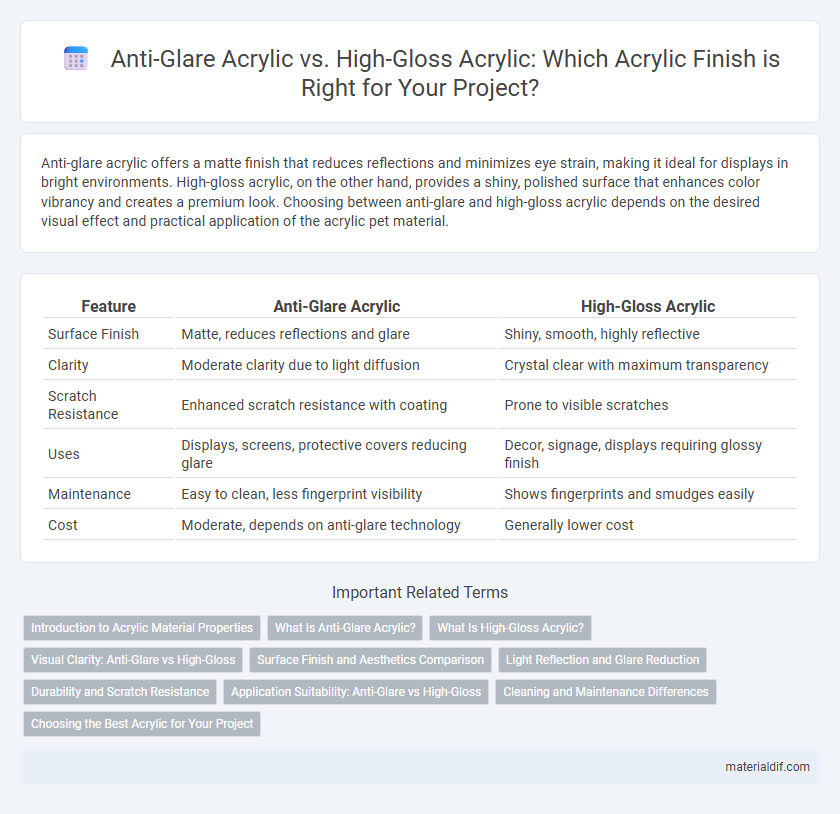Anti-glare acrylic offers a matte finish that reduces reflections and minimizes eye strain, making it ideal for displays in bright environments. High-gloss acrylic, on the other hand, provides a shiny, polished surface that enhances color vibrancy and creates a premium look. Choosing between anti-glare and high-gloss acrylic depends on the desired visual effect and practical application of the acrylic pet material.
Table of Comparison
| Feature | Anti-Glare Acrylic | High-Gloss Acrylic |
|---|---|---|
| Surface Finish | Matte, reduces reflections and glare | Shiny, smooth, highly reflective |
| Clarity | Moderate clarity due to light diffusion | Crystal clear with maximum transparency |
| Scratch Resistance | Enhanced scratch resistance with coating | Prone to visible scratches |
| Uses | Displays, screens, protective covers reducing glare | Decor, signage, displays requiring glossy finish |
| Maintenance | Easy to clean, less fingerprint visibility | Shows fingerprints and smudges easily |
| Cost | Moderate, depends on anti-glare technology | Generally lower cost |
Introduction to Acrylic Material Properties
Acrylic is a versatile thermoplastic known for its clarity, impact resistance, and lightweight properties, commonly used in glazing, displays, and signage. Anti-glare acrylic features a matte finish that diffuses light to reduce reflections and improve visibility in bright environments. High-gloss acrylic offers a smooth, reflective surface that enhances color vibrancy and provides a sleek, polished appearance.
What Is Anti-Glare Acrylic?
Anti-glare acrylic features a matte finish that diffuses light to reduce reflections and glare, enhancing visibility in bright environments. This type of acrylic is ideal for display cases, digital screens, and protective covers where minimizing reflections improves user experience. Its surface texture contrasts with high-gloss acrylic, which provides a shiny, reflective finish that maximizes color vibrancy but can cause glare issues.
What Is High-Gloss Acrylic?
High-gloss acrylic is a type of acrylic sheet known for its smooth, mirror-like finish that enhances color vibrancy and sharpness in displays and signage. Its reflective surface provides superior clarity and depth, making it ideal for applications requiring a sleek and polished appearance. Compared to anti-glare acrylic, high-gloss acrylic offers increased light reflection but can be prone to visible fingerprints and glare under strong lighting conditions.
Visual Clarity: Anti-Glare vs High-Gloss
Anti-glare acrylic reduces reflections and diffuses light, enhancing visibility and reducing eye strain in bright environments. High-gloss acrylic offers superior clarity with a smooth, reflective surface that intensifies colors and sharpness but may cause glare under direct light. Choosing between anti-glare and high-gloss acrylic depends on the balance between minimizing glare and maximizing vibrant visual clarity.
Surface Finish and Aesthetics Comparison
Anti-glare acrylic features a matte surface finish that minimizes reflections and glare, enhancing visibility and reducing eye strain in bright environments. High-gloss acrylic offers a smooth, shiny finish that maximizes light reflection, delivering vibrant color depth and a polished, premium appearance. The choice between anti-glare and high-gloss acrylic depends on whether clarity under bright light or a striking, lustrous aesthetic is the priority.
Light Reflection and Glare Reduction
Anti-glare acrylic features a matte finish that scatters light, significantly reducing reflections and minimizing eye strain in brightly lit environments. High-gloss acrylic offers a smooth, shiny surface that enhances color vibrancy but can produce stronger light reflections and noticeable glare under direct lighting. Selecting between anti-glare and high-gloss acrylic depends on balancing the need for reduced glare with the desired visual impact and clarity.
Durability and Scratch Resistance
Anti-glare acrylic features a matte finish that enhances durability by reducing visible scratches and surface imperfections, making it ideal for high-traffic environments. High-gloss acrylic offers superior scratch resistance due to its smooth, hard surface but is more prone to showing fingerprints and smudges. Both types provide strong impact resistance typical of acrylic materials, yet choosing between anti-glare and high-gloss depends on the balance between aesthetic preference and functional wear resistance.
Application Suitability: Anti-Glare vs High-Gloss
Anti-glare acrylic is ideal for environments requiring reduced reflections and glare, such as computer screens, display cases, and signage in brightly lit areas, enhancing visibility and eye comfort. High-gloss acrylic, with its polished, mirror-like finish, suits applications where aesthetic appeal and vibrant color presentation are prioritized, like retail displays, decorative panels, and automotive trim. Choosing between anti-glare and high-gloss acrylic depends on balancing functional lighting needs and desired visual impact in specific use cases.
Cleaning and Maintenance Differences
Anti-glare acrylic features a matte surface that resists fingerprints and smudges, making it easier to clean with mild soap and a soft cloth without leaving streaks. High-gloss acrylic requires more frequent cleaning due to its reflective finish, which shows dust, smudges, and scratches more prominently and often necessitates specialized, non-abrasive cleaners. Proper maintenance of anti-glare acrylic prolongs its anti-reflective properties, while high-gloss acrylic benefits from careful handling to preserve its shiny appearance.
Choosing the Best Acrylic for Your Project
Anti-glare acrylic offers reduced reflections and enhanced visibility, making it ideal for display cases, signage, and screens where clarity under various lighting conditions is crucial. High-gloss acrylic provides a shiny, mirror-like finish that boosts visual appeal and depth, perfect for decorative applications and modern furniture designs. Selecting the best acrylic depends on balancing aesthetic preferences with functional needs, such as anti-reflective performance or high-gloss appearance for impact.
Anti-Glare Acrylic vs High-Gloss Acrylic Infographic

 materialdif.com
materialdif.com